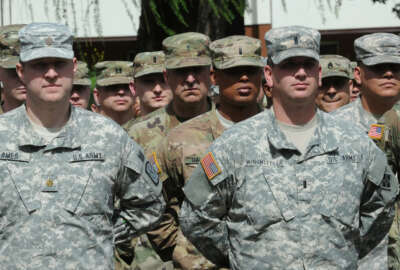
Readiness is nearly restored, top military officials say
After years of uncertain budgets and constant war, the military services say they are near adaquate readiness levels.
Best listening experience is on Chrome, Firefox or Safari. Subscribe to Federal Drive’s daily audio interviews on Apple Podcasts or PodcastOne.
After years of telling Congress that readiness was slipping to dangerous levels, both the Army and Navy say their forces are almost back to an acceptable posture to address global threats.
The Army’s top officer and the Navy’s second highest ranking sailor said this week that force structures are beginning to hit acceptable levels and maintenance backlogs are starting to decline.
“The Army has made tremendous progress in the last several years,” Army Chief of Staff Gen. Mark Milley said Wednesday in Arlington, Virginia, during an Association of the United States Army event. “We’ve recovered from depleted levels of readiness brought about by extended periods of sustained conflict in the current wars, and also by reduced defense spending over a period of many, many years.”
Milley warned that the Army is not completely “out of the hole,” but is working its way toward its goal.
Likewise, Vice Chief of Naval Operations Adm. Bill Moran told the Surface Navy Association on Tuesday that the Navy is in a similar position.
“There is no doubt we are on a better trajectory,” Moran said during his speech in Arlington, Virginia. “We are now seeing concrete signs of progress, where leaders are thinking differently, planning for the future and owning readiness again.”
Moran said the Navy’s current and improving dialogue with industry is an example of how the Navy is thinking differently to increase readiness.
“We, industry, fleet planners, Naval Sea Systems Command and [the Navy’s Pentagon staff] all have to be on the same page if we are going to answer the bell in the fleet,” Moran said. “On time and on budget is a two-way street and a partnership is the only way we’re going to work this backlog down over time. It’s the only way we are going to improve the reliability of our systems and it’s the only way we’re going to truly establish configuration control.”
Milley also laid out ways the Army is moving forward with readiness. The service is in the process of filling its operational units to 100 percent of authorized strength by the end of 2019. Combat units will be manned to 105 percent by 2020.
The Army also reduced the nondeployable rates of soldiers from 15 percent in 2015 to between 6 percent and 7 percent. The Army plans to bring the nondeployable rate down to 5 percent by the end of the year.
The Army is growing as well.
“With congressional support we are building, with modest growth, the Army, the National Guard and the Army Reserve to an army that we need in our future,” Milley said. “We are going to do that without compromising out quality.”
Keeping that quality comes with increased training. Infantry training increased from 14 weeks to 22 weeks and the Army also increased its training days for the National Guard.
The Army is implementing synthetic training environments to simulate different terrains and piloting a new fitness test to prepare for more rugged combat.
Milley said readiness also came in the form of equipment.
“Army Material Command has increased the flow of spare parts, inventory and ammunition stockpiles,” he said.
A dubious past and future
While the services seem to be on track now, it wasn’t always that way.
Moran admitted the Navy got off to a slow start when it began to restore readiness.
“We did not initially respond very well to the injection of cash,” Moran said. “Our systems and our processes were not optimized or tuned for speed, execution, contracts or for making wise investments. We were frankly hampered by a mindset of scarcity.”
The Army also took some time to get its feet under it. Understanding the need for speed in acquisition in building readiness and preparing for near-peer competition, the service spent time setting up a Futures Command to streamline acquisition and focus on future technologies.
Keeping readiness going may be a challenge, though.
In an interview with Federal News Network last month, Navy Secretary Richard Spencer likened the Navy’s current readiness status to riding a bicycle: It takes a few pedals to find your balance. The Navy is now in that vulnerable position of heading in the right direction, but any slight setback could harm progress, Spencer said.
Additionally, sequestration will return in 2020 unless Congress comes to a budget deal. If sequestration takes effect, both services will lose tens of billions of dollars compared to the 2019 budget.
Copyright © 2025 Federal News Network. All rights reserved. This website is not intended for users located within the European Economic Area.
Scott Maucione is a defense reporter for Federal News Network and reports on human capital, workforce and the Defense Department at-large.
Follow @smaucioneWFED





